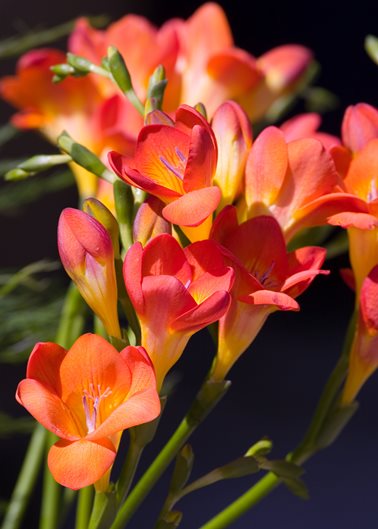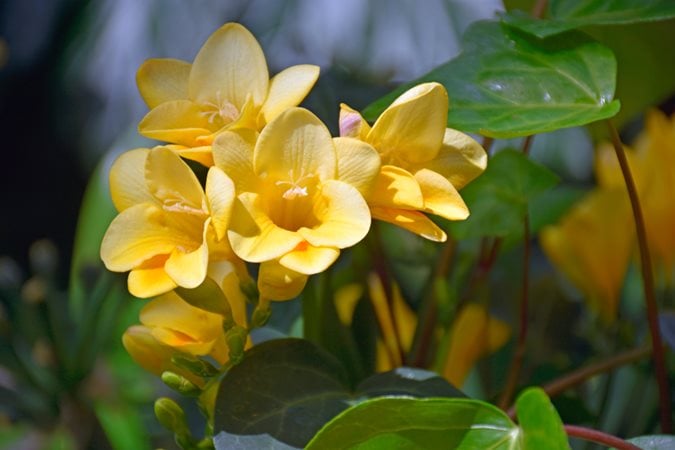Freesia: A Fragrant Jewel of the Garden

Freesia, with its delicate, trumpet-shaped blossoms and intoxicating fragrance, is a beloved flower enjoyed by gardeners and florists alike. Native to South Africa, these cormous perennials bring a touch of elegance and a burst of color to spring gardens and indoor arrangements. Beyond their aesthetic appeal, freesias possess a rich history and a fascinating biology, making them a truly captivating subject for exploration.
A History Woven with Discovery and Romance:
The freesia’s story begins in the 19th century, specifically in the Cape region of South Africa. The plant was named in honor of Friedrich Heinrich Theodor Freese, a German physician and botanist, by his friend Christian Friedrich Ecklon, a fellow botanist. This act of friendship immortalized Freese, ensuring his name would forever be associated with the fragrant flower.
Early varieties were predominantly white or pale yellow, but through selective breeding, a vibrant palette of colors emerged. These included shades of pink, red, orange, purple, and even bi-colored varieties, each adding its own unique charm to the freesia’s repertoire.
The flower’s introduction to Europe and North America sparked a wave of enthusiasm, leading to its widespread cultivation and hybridization. Commercial growers recognized the freesia’s potential as a cut flower due to its long vase life, appealing fragrance, and the ease with which it could be transported. Today, freesias are a staple in the floral industry, gracing bouquets, corsages, and floral arrangements worldwide.
Botanical Insights: Unveiling the Freesia’s Secrets:
Freesias belong to the Iridaceae family, a diverse group of flowering plants that also includes irises, gladioli, and crocuses. They are characterized by their corms, underground storage organs that resemble bulbs but are actually modified stems. These corms allow the plant to survive through dormancy periods, emerging in the spring with renewed vigor.
Freesia plants typically reach a height of 12-18 inches (30-45 cm). Their leaves are linear and sword-shaped, providing a backdrop for the star of the show: the fragrant blossoms. The flowers are arranged in a one-sided, comb-like inflorescence, known as a spike. Each spike can hold several individual flowers, which open sequentially, extending the bloom period.
The freesia’s fragrance is often described as sweet, floral, and slightly spicy, with hints of citrus or honey. This intoxicating scent is due to a complex blend of volatile organic compounds (VOCs) released by the flowers. The specific composition of these VOCs can vary depending on the freesia variety, contributing to the subtle nuances in fragrance.
Cultivating Freesia: A Guide to Growing These Fragrant Beauties:

Growing freesias can be a rewarding experience, allowing you to enjoy their beauty and fragrance in your own garden or home. Here’s a guide to successful freesia cultivation:
- Choosing the Right Variety: With numerous cultivars available, selecting the right variety is crucial. Consider factors such as color, fragrance intensity, and bloom time. Single-flowered varieties tend to be more fragrant than double-flowered ones. Some popular varieties include ‘Alba’ (white), ‘Red Beauty’ (red), ‘Yellow River’ (yellow), and ‘Blue Heaven’ (purple).
- Planting Time and Location: Freesias thrive in sunny locations with well-drained soil. In colder climates (zones 8 and below), plant corms in the spring after the last frost. In warmer climates (zones 9-10), plant corms in the fall for winter or early spring blooms. Choose a location that receives at least 6 hours of sunlight per day.
- Soil Preparation: Freesias prefer slightly acidic to neutral soil (pH 6.0-7.0). Amend the soil with compost or well-rotted manure to improve drainage and fertility. Avoid heavy clay soils, as they can lead to corm rot.
- Planting Depth and Spacing: Plant freesia corms approximately 2 inches (5 cm) deep and 2-3 inches (5-8 cm) apart. Ensure the pointed end of the corm faces upwards.
- Watering: Water freesia corms thoroughly after planting. Keep the soil consistently moist but not waterlogged during the growing season. Reduce watering after flowering as the plants enter dormancy.
- Fertilizing: Feed freesias with a balanced fertilizer every 2-3 weeks during the growing season. Choose a fertilizer that is high in phosphorus to promote flower production.
- Support: Freesias can become top-heavy when in bloom, so provide support with stakes or netting to prevent them from flopping over.
- Pest and Disease Control: Freesias are generally pest-resistant, but they can be susceptible to aphids, spider mites, and thrips. Control pests with insecticidal soap or neem oil. Corm rot can be a problem in poorly drained soils. Prevent corm rot by ensuring good drainage and avoiding overwatering.
- Dormancy: After flowering, the leaves will begin to yellow and die back. This is a sign that the plants are entering dormancy. Reduce watering and allow the foliage to die back completely. In colder climates, dig up the corms and store them in a cool, dry place until the following spring. In warmer climates, the corms can be left in the ground.

Freesia in Floral Design: Adding Elegance and Fragrance to Arrangements:
Freesias are a favorite among florists due to their beauty, fragrance, and long vase life. They are often used in bridal bouquets, corsages, and other floral arrangements. Here are some tips for using freesias in floral design:
- Choose stems with several unopened buds: This will ensure that the arrangement lasts longer as the buds open sequentially.
- Cut stems at an angle: This will increase the surface area for water absorption.
- Remove any leaves below the waterline: This will prevent bacterial growth and prolong the vase life.
- Use a floral preservative: This will provide nutrients and help to keep the water clean.
- Change the water every 2-3 days: This will help to keep the flowers fresh.
- Display freesias in a cool location: Avoid direct sunlight and drafts.
Freesias pair well with a variety of other flowers, including roses, lilies, tulips, and carnations. Their delicate fragrance complements other floral scents, creating a harmonious and pleasing aroma.
Beyond Aesthetics: Freesia in Perfumery and Aromatherapy:
The freesia’s captivating fragrance has also made it a popular ingredient in perfumes and aromatherapy products. The essential oil extracted from freesia flowers is used to create perfumes, lotions, and other scented products.
In aromatherapy, freesia essential oil is believed to have mood-boosting and stress-relieving properties. Its sweet and floral scent can help to promote relaxation, reduce anxiety, and uplift the spirits.
Conclusion: A Fragrant Legacy:
From its humble beginnings in the Cape region of South Africa to its widespread popularity as a cut flower and perfume ingredient, the freesia has carved a fragrant legacy for itself. Its delicate blossoms, intoxicating scent, and vibrant colors continue to captivate and inspire. Whether grown in the garden, displayed in a vase, or used in a perfume, the freesia offers a touch of elegance and a reminder of the beauty and fragrance that nature has to offer.
Frequently Asked Questions (FAQ) about Freesia:
Q: Are freesias annuals or perennials?
A: Freesias are cormous perennials, meaning they live for more than two years and regrow from their underground corms each year.
Q: Are freesias difficult to grow?
A: Freesias are relatively easy to grow with proper care. They require well-drained soil, plenty of sunlight, and regular watering during the growing season.
Q: When is the best time to plant freesia corms?
A: In colder climates (zones 8 and below), plant corms in the spring after the last frost. In warmer climates (zones 9-10), plant corms in the fall for winter or early spring blooms.
Q: How often should I water my freesias?
A: Water freesias thoroughly after planting. Keep the soil consistently moist but not waterlogged during the growing season. Reduce watering after flowering as the plants enter dormancy.
Q: Do freesias need fertilizer?
A: Yes, feed freesias with a balanced fertilizer every 2-3 weeks during the growing season. Choose a fertilizer that is high in phosphorus to promote flower production.
Q: How do I store freesia corms over the winter?
A: In colder climates, dig up the corms after the foliage has died back completely. Clean the corms and store them in a cool, dry place until the following spring.
Q: Are freesias fragrant?
A: Yes, freesias are known for their intoxicating fragrance, which is often described as sweet, floral, and slightly spicy.
Q: What are some popular freesia varieties?
A: Some popular varieties include ‘Alba’ (white), ‘Red Beauty’ (red), ‘Yellow River’ (yellow), and ‘Blue Heaven’ (purple).
Q: Can I grow freesias in pots?
A: Yes, freesias can be grown in pots. Choose a pot that is at least 6 inches deep and wide. Use a well-draining potting mix and provide adequate sunlight and water.
Q: Are freesias deer resistant?
A: Freesias are generally considered to be deer resistant, although deer may occasionally nibble on them.
Final Conclusion:
The Freesia, with its captivating beauty and intoxicating fragrance, truly earns its place as a gem in the gardening world. This South African native, named in honor of a botanist’s friend, has evolved from simple white and yellow hues to a vibrant spectrum of colors, each variety offering its unique charm. Beyond its aesthetic appeal, the freesia possesses a fascinating botanical makeup, thriving from underground corms and releasing a complex blend of volatile organic compounds that create its signature scent.
Whether you’re a seasoned gardener or a novice, cultivating freesias can be a rewarding experience. By providing them with ample sunlight, well-drained soil, and consistent care, you can enjoy their beauty and fragrance in your own garden or home. From floral arrangements to perfumes, the freesia’s versatility shines, adding elegance and a touch of nature’s magic to every setting. So, embrace the allure of the freesia and let its fragrant legacy fill your life with beauty and joy.
